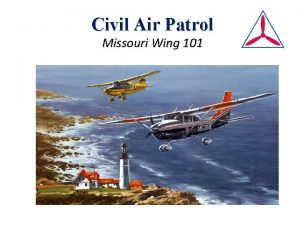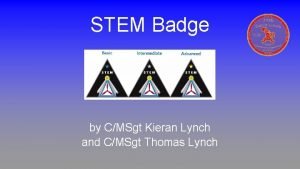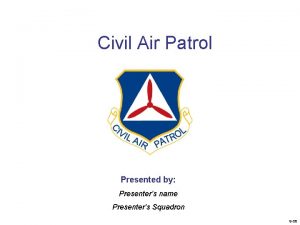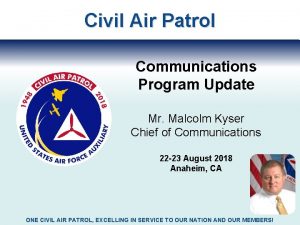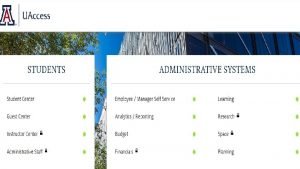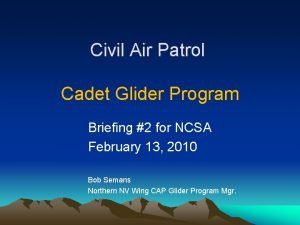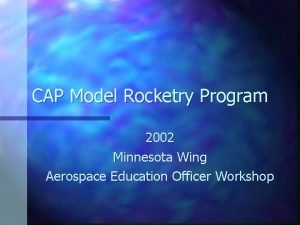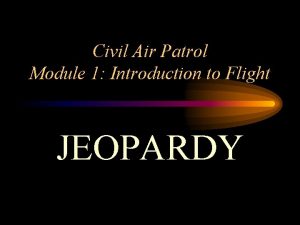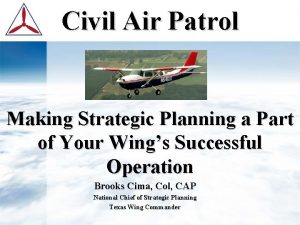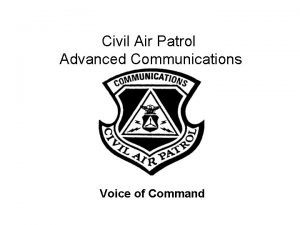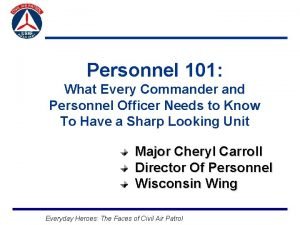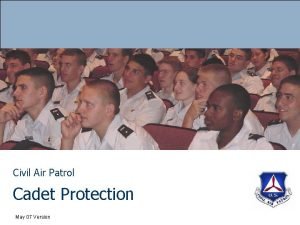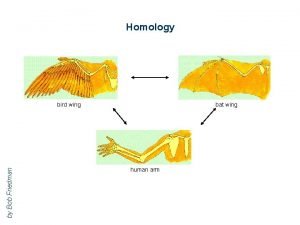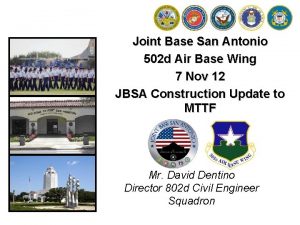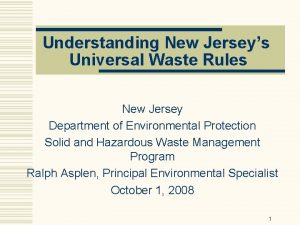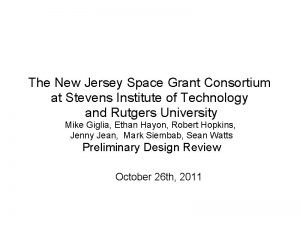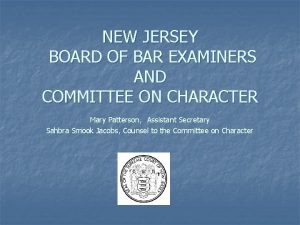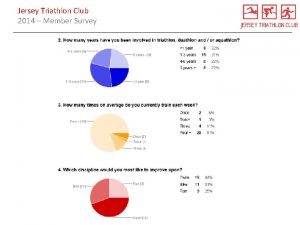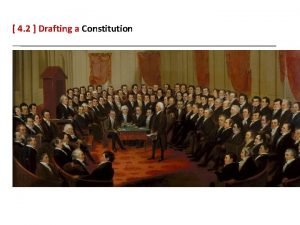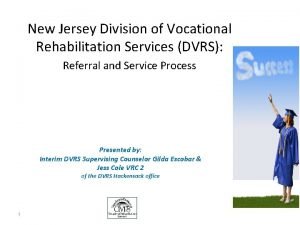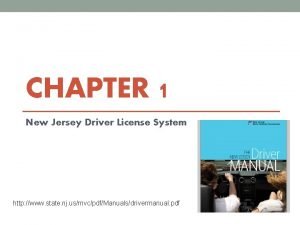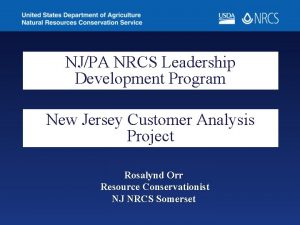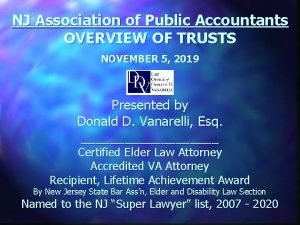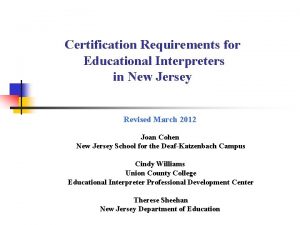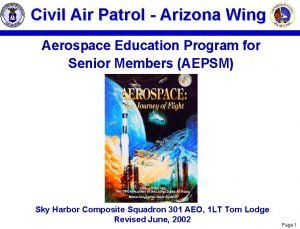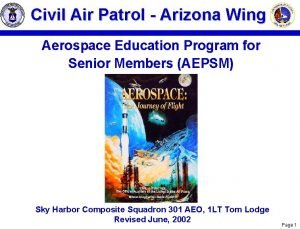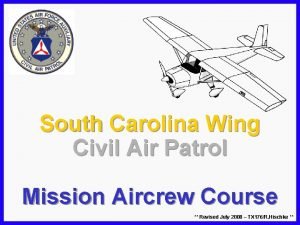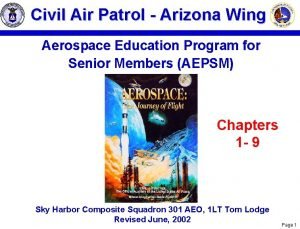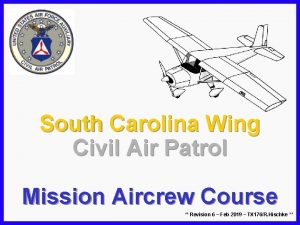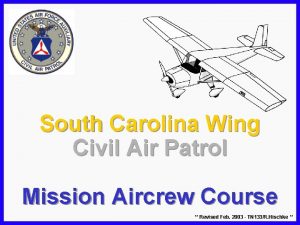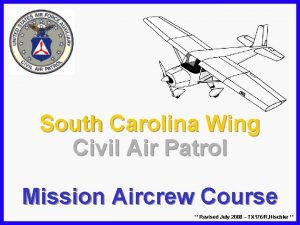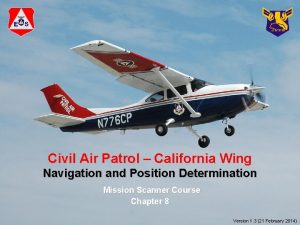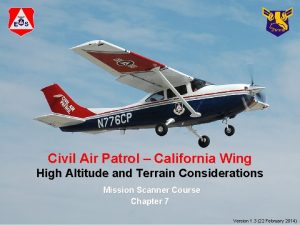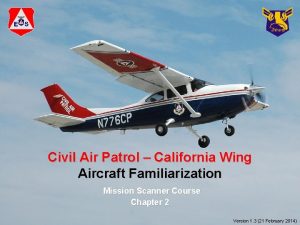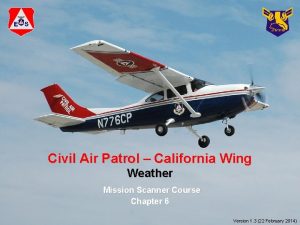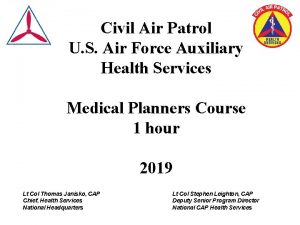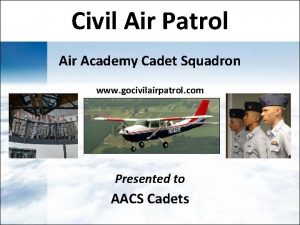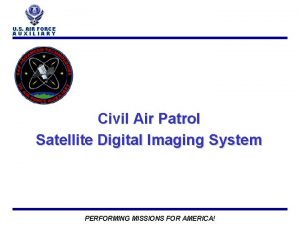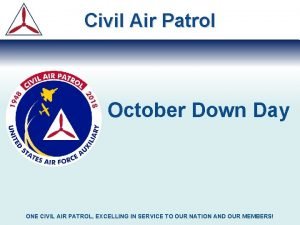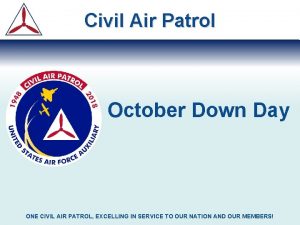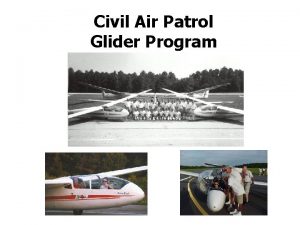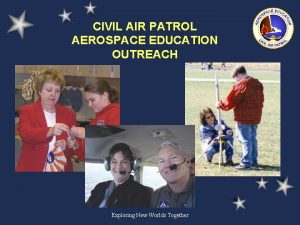Civil Air Patrol New Jersey Wing G 1000
























































- Slides: 56

Civil Air Patrol – New Jersey Wing G 1000 Presentation For IFR Pilots Overview Maj William J. Doyle, Jr. Civil Air Patrol, New Jersey Wing, Stan. Eval Officer Check Pilot Examiner / Check Pilot / Instructor-Pilot CFI A&I, AGI, IGI, CFAI, FAAST Rep (PHL) 22 NOV 2015

How Good Are Your IFR Skills? 09/04/2004 En Route KMIV to KDYL in Cirrus SR 20

NHQ G 1000 Training Structure • NHQ Training Philosophy o Minimize risks associated with over-dependency on automation o Emphasize “eyes outside the cockpit” and “hands-on” flying skills • G 1000 VFR Pilot – same structure for ground and flying o Emphasis on cross-country navigation, diversions, system use o Module #1 – system (“knobology”) and “hands-on” flying o Module #2 – use of the autopilot • G 1000 IFR Pilot – same structure for ground and flying o Emphasis on instrument techniques: enroute, holds, and approaches (ILS, GPS/RNAV) o Module #1 – system (“knobology”) and “hands-on” flying o Module #2 – use of the autopilot

Instructor Ground Course – Training Matrix

Preparation for Instruction • Overview of Horizontal Situation Indicators (HSIs) – Many CAP pilots are unfamiliar with the HSI. • Bendix-King PNI 525 Tutorial #049. pdf • Bendix-King PNI 525 Tutorial #066. pdf • Century NSD 1000 HSI 68 S 85. pdf • Wikipedia Horizontal Situation Indicator • Overview of Technologically Advanced Aircraft (TAAs) – The links below are to FAA Safety Seminars on TAAs and GPS • http: //williamjdoylejr. net/FAAST/TAA. ppt • http: //williamjdoylejr. net/FAAST/gps. ppt

Overview of IFR G 1000 Ground Course • Course Overview – NHQ intends that all ground instruction will be face-to-face – The IFR G 1000 Ground Course will be a full day course – G 1000 IFR Pilot Course Overview • IFR Ground Course and Flight Scenarios – G 1000 IFR Ground Course Module #1 – 99 slides – G 1000 IFR Ground Course Module #2 – 153 slides – G 1000 IFR Flight Scenario #1 – G 1000 IFR Flight Scenario #2 • IFR Ground Course and Flight Approval Forms – NJWG Request for G 1000 Flight Training – created by Maj Tom Woods

Materials for IFR Pilot Ground Course • Pilot Resources – G 1000 Information – Ground School Study Guide – Version 10 a – for GFC 700 (N 941 CP) – Cessna G 1000 Power. Point – for GFC 700 (N 941 CP) – 150 MB – N 941 CP – includes POH, Weight & Balance, Cessna G 1000 Power. Point for GFC 700, Check List – N 355 CP – includes POH, Weight & Balance, Cessna G 1000 Power. Point for KAP 140 (150 MB), Check List, KAP 140 Guide, Altitude Pre-Select – CAPR 60 -1 – see text in yellow highlights for G 1000 changes – CAPF-5 (Word) – new version effective 1 JUL 2015 – CAPF-5 (PDF) – new version effective 1 JUL 2015 – Garmin G 1000 PC Trainer for Cessna NAV III, Version 12. 0 • Good investment, buy it for yourself, urge your students to do the same • $24. 95 plus $8. 00 shipping • https: //buy. garmin. com/shop. do? p. ID=113763

Overview of G 1000 IFR Ground Course • CAPF-5 Flight Evaluation Form – 1 JUL 2015 – CAPF-5 Word document – CAPF-5 Adobe PDF • Top portion shown below

What is CFIT? Controlled Flight into Terrain

Anything Wrong With This Picture?

What About This Picture?

So What Do You Think? CFIT in the Making?

CAP CFIT Accident Las Vegas, NV 8 NOV 2007

Night VMC Takeoff Accident in T 182 T G 1000 - CFIT • Controlled Flight into Terrain (CFIT) with two fatalities – N 881 CP – NTSB Factual Report – click link below http: //www. ntsb. gov/aviationquery/Gen. PDF. aspx? id=SEA 08 FA 023&rpt =fa – NTSB Probable Cause – click link below http: //www. ntsb. gov/aviationquery/brief. aspx? ev_id=20071121 X 01832 &key=1 – Crew Experience and FAA Certificates • Pilot (left seat): – ATP AMEL, Commercial ASEL, 25, 000 hours total time, G 1000 trained (74. 7 hours G 1000, 34. 2 hours in accident airplane) • Pilot (right seat): – ATP AMEL, helicopter, CFI, AGI, IGI, 28, 000 hours total time, not G 1000 trained

Night VMC Takeoff Accident in T 182 T G 1000 - CFIT • Controlled Flight into Terrain (CFIT) with two fatalities – N 881 CP – Events from night of 11/08/2007 • Departed North Las Vegas Airport (VGT), Las Vegas, NV on a VFR flight plan about 19: 05 Local PST bound for Rosamond Skypark Airport (L 00), Rosamond, California • 19: 05: 29 Local PST - checked in with ATC at 2, 700 feet MSL • 19: 17: 29 Local PST - radar contact lost, airplane impacted 1, 000 feet below summit of Mt. Potosi (elevation = 8, 514 feet MSL) • Fireball from impact witnessed by law enforcement helicopter – Interviews with the ATC Controller produced the following • Controller stated, "The aircraft looked fine - there was nothing unusual about it. ” • When questioned about where he expected the aircraft to go the controller replied that “. . . the pilot was on his own navigation. ” • Controller stated that other aircraft he has seen go where the accident aircraft was, and some go further south. • Asked when he is required to issue a safety alert, the controller stated, in his opinion, when an aircraft is close to terrain or other aircraft.

Night VMC Takeoff Accident in T 182 T G 1000 - CFIT • Controlled Flight into Terrain (CFIT) with two fatalities – N 881 CP – Conditions of Flight • Accident occurred during dark night under visual meteorological conditions. • No lighted roads or round structures were present in the area to provide ground reference to terrain. • 1% of the moon’s disk was illuminated. – Airplane climb performance over last six minutes of flight per recorded radar data • Average groundspeed was 100 knots • Average rate of climb was 406 fpm (feet per minute) • Note: an average rate of climb of 600 fpm was required to clear terrain along the flight path.

Night VMC Takeoff Accident in T 182 T G 1000 - CFIT • Controlled Flight into Terrain (CFIT) with two fatalities – N 881 CP – NTSB Findings 1. 2. 3. 4. 5. (F) TERRAIN CONDITION - RISING (F) TERRAIN CONDITION - MOUNTAINOUS/HILLY (F) LIGHT CONDITION - DARK NIGHT (C) ALTITUDE/CLEARANCE - NOT MAINTAINED - PILOT IN COMMAND (F) OTHER PSYCHOLOGICAL CONDITION - PILOT IN COMMAND a) Ethanol b) Diphenhydramine (Benadryl) 6. (F) PROCEDURES/DIRECTIVES - NOT FOLLOWED - ATC PERSONNEL (ARTCC) 7. (F) SAFETY ADVISORY - NOT ISSUED - ATC PERSONNEL (ARTCC) – Legend • (F) – Factor • (C) – Cause

Night VMC Takeoff Accident in T 182 T G 1000 - CFIT • Controlled Flight into Terrain (CFIT) with two fatalities – N 881 CP – Lessons Learned • Know necessary climb out rate – Conversion formula for Feet Per NM to Feet Per Minute (FPM) • Feet Per NM / feet in NM * 100 * ground speed (per G 1000) – VGT Northtown Three Departure from Runway 30 L uses 415 feet per NM • 415 / 6072 * 100 = 683 FPM – VGT Boulder City One Departure from Runway 30 L uses 367 feet per NM • 367 / 6072 * 100 = 604 FPM • Do not depend on ATC for terrain separation • File for an instrument departure • Know the airplane’s equipment – See G 1000 illustration on terrain avoidance

Night VMC Takeoff Accident in T 182 T G 1000 - CFIT • Controlled Flight into Terrain (CFIT) with two fatalities – N 881 CP – G 1000 illustration on terrain avoidance • PDF inset or MFD – Red – 100 feet AGL or less – Yellow – more than 100 feet AGL but less than 1000 feet AGL – Black – 1000 feet AGL or higher

Overview of GPS and GPS Approaches

GPS – Global Positioning System • Space-based radio-navigation system consisting of – Constellation of solar-powered satellites – Network of ground reference stations • Minimum of 24 GPS satellites – Orbit the Earth • Altitude of ≈ 11, 000 – 12, 000 miles • Orbital velocity ≈ 7, 000 mph • Two complete orbits every 24 hours – Provide accurate information on position, velocity, and time • • Anywhere in the world In all weather conditions Non-WAAS receivers accurate to ≤ 15 meters WAAS receivers accurate to ≤ 3 meters

RNAV Approaches – AIM References • AIM Chapter 5 – Air Traffic Procedures – Section 5 -4 -5 – Instrument Approach Procedure Charts – LNAV – Lateral Navigation § Non-precision approach, descend at desired rate to MDA – LNAV+V – Lateral Navigation with Vertical Navigation § Non-precision approach, descend along WAAS Advisory Glide Path to MDA – LNAV/VNAV – Lateral Navigation with Vertical Navigation § Approach with Vertical Guidance (APV), descend along WAAS Glide Path to DA – LPV – Localizer Performance with Vertical Guidance. § Approach with Vertical Guidance (APV), descend along WAAS Glide Path to DA. § GLS – ICAO GNSS (Global Navigation Satellite System) Landing System. Referenced as LPV in United States.

NJWG WAAS-Enabled Aircraft • N 355 CP – not WAAS-Enabled • N 941 CP – WAAS-Enabled

National List of GPS Approaches • http: //www. faa. gov/about/office_org/headquarters_offices/ato/service_units/ techops/navservices/gnss/approaches/

National List of GPS Approaches • http: //www. faa. gov/about/office_org/headquarters_offices/ato/service_units/ techops/navservices/gnss/approaches/ - scroll down

National List of GPS Approaches • http: //www. faa. gov/about/office_org/headquarters_offices/ato/service_units/ techops/navservices/gnss/approaches/ - scroll down

National List of GPS Approaches

National List of GPS Approaches • http: //www. faa. gov/about/office_org/headquarters_offices/ato/service_units/ techops/navservices/gnss/approaches/

National List of GPS Approaches • FAA Spreadsheet of GNS-GPS/WAAS Approaches (Last Updated 01/08/2015) http: //www. faa. gov/about/office_org/headquarters_offices/ato/service_units/techops/navserv ices/gnss/approaches/ http: //williamjdoylejr. net/G 1000_2013/G 1000_Pilot_IFR_Course/2015 -0108_Master. RNAVs. xlsx • Note: – This spreadsheet includes worksheet tabs for the following types of approaches • • • GPS Standalone Approaches LNAV Approaches LP Approaches VNAV Approaches LPV Approaches – This list does not include overlay types of approaches, such as • VOR Overlays • NDB Overlays – Specific approach types can be selected by clicking on the worksheet tabs as shown in the screen shot below.

RNAV LNAV Approaches – NJ

RNAV LNAV Approaches – NJ

RNAV LNAV Approaches – NJ

RNAV LNAV Approaches – NJ

National List of GPS Approaches – NJ • • Applies to each spreadsheet tab Ability to filter by state, city, airport State filtering set to NJ Airports filtered for New Jersey

RNAV/GPS Approach Minima • LPV DA (Decision Altitude): 300 ft AGL with 1 SM visibility • LNAV/VNAV DA (Decision Altitude): 400 ft AGL with 1¼ SM visibility • LNAV MDA (Minimum Descent Altitude): 500 -600 ft AGL with 1 - 1⅝ SM visibility • Circling: 600 ft AGL with 1 - 2 SM visibility

LNAV (Lateral Navigation) • Non-precision approach • Descend at desired rate to MDA • Fly level at MDA – Until runway environment in sight – then land, or – To MAP – then begin missed approach procedure

LNAV + V (Lateral Navigation plus Vertical Guidance) • Non-precision approach • Descend along WAAS Advisory GP to MDA • Fly level at MDA – Until runway environment in sight – then land, or – To MAP – then begin missed approach procedure

LNAV / VNAV (Lateral Navigation / Vertical Navigation) • Non-precision approach • Descend along WAAS Advisory GP to DA • At DA – make a decision – If runway environment in sight – land, or – If runway environment not in sight– then missed approach procedure

LPV (Localizer Performance with Vertical Guidance) • Approach with Vertical Guidance (APV) • Descend along WAAS Advisory GP to DA • At DA – make a decision – If runway environment in sight – land, or – If runway environment not in sight– then missed approach procedure

RNP (Required Navigation Performance) • RNP-capable flight management system (FMS) utilizes enhanced software to monitor sensor inputs and compare real time navigation accuracy, also referred to as Actual Navigation Performance (ANP). • Navigation performance for a particular RNP type is expressed numerically. – Depending on the capability of each aircraft's system, RNP values can be as low as 0. 1 nautical miles. – A performance value of RNP 0. 3, for instance, assures that the aircraft has the capability of remaining within 0. 3 nautical miles to the right or left of the centerline 95% of the time and within a linear containment area of 0. 6 nautical miles (twice the RNP value) 99. 999% of the time.

RNP (Required Navigation Performance) • RNP approaches for KTTN – Runway 6 – Runway 24

RNAV/GPS Approach Minima - Glidepath • No glidepath – LNAV • WAAS-derived Glidepath – loss of signal downgrades to LNAV – LNAV + V – LNAV/VNAV – LPV

RNAV/GPS Approach Minima – Obstacle Evaluation Area • Wider Obstacle Evaluation Area – LNAV + V – LNAV/VNAV • Narrower Obstacle Evaluation Area – LPV

Cessna Comparison of Obstacle Evaluation Area

Cessna Comparison of Full Scale CDI Deflection

Autopilot Approach Reference Slides for Cessna G 1000 Power. Point Presentations • Cessna G 1000 with KAP 140 Autopilot – Slides 239 – 279 • CDI Nav Source Change and ROL Mode slides 262 - 265 • Missed Approach Procedures slides 268 - 279 • Cessna G 1000 with GFC 700 Flight Control – Slides 273 - 302

What Are the Risks in Flying a Technologically Advanced Aircraft (TAA)?

What Are the Risks with Flying TAA? • Risk: Lack of Pilot Proficiency – Mitigation: study, study then practice, practice • Get the Garmin G 1000 for Cessna NAV III simulator • Download training videos, manuals (PDF), flight planning lessons • Get some ground instruction and flight instruction from your CFI

What Are the Risks with Flying TAA? • Risk: Head in the Cockpit Instead of Outside – Mitigation: Set up as much as possible on the ground • Do your flight planning at home before coming to the airport – File an FAA flight plan (consider filing IFR even if VMC) – Print a navigation log (consider Fore. Flight or AOPA Fly. Q Web) • Set up flight plan in GPS after preflight and engine start but before taxi – Contact Clearance Delivery on radio or cell phone – Set up clearance route in your GPS

What Are the Risks with Flying TAA? • Risk: Single Pilot IFR – Mitigation: Take an experienced pilot or CFI • Establish personal minimums, don’t deviate from them – Consider establishing a risk management matrix – Refer to next section on personal minimums • Build experience – When appropriate, appropriate revise your personal minimums

What Are the Risks with Flying TAA? • Risk: Thunderstorm Penetration – Mitigation: Avoid thunderstorms • Do not use Nex. Rad or Strike Finder features to penetrate thunder Storms • Use Nex. Rad or Strike Finder features to avoid thunder Storms – Preferably by putting the T-Storms at your six o’clock

What Are the Risks with Flying TAA? • Risk: Thunderstorm Penetration

What Are the Risks with Flying TAA? • Other Things You Should Consider – Nex. Rad near real-time weather – Nex. Rad near real-time TFR – Time lags can be >15 minutes • Keep your databases up to date – As part of pre-flight, check to make sure that the databases are current

What Are the Risks with Flying TAA? • Foster/practice continuing pilot education and self-study • Cessna G 1000 Reference Manuals – Cessna Nav. III G 1000 Cockpit Reference Guide Oct 2011 Rev A – Cessna Nav. III G 1000 Pilot Guide Oct 2011 Rev A • AOPA/ASF on Technologically Advanced Aircraft – AOPA/ASF TAA - 2007 • FAA Handbooks – FAA Risk Management Handbook – See Appendix A for Personal Minimums – Instrument Flying Handbook (FAA-H-8083 -15 B) – Instrument Procedures Handbook (FAA-H-8261 -1 A)

Overview of CAP G 1000 Mission Observer Ground Course

Mission Observer G 1000 Ground Course • Lesson Structure – G 1000 MO Lesson 01 - Introduction – 47 slides – G 1000 MO Lesson 02 - Components and Systems – 35 slides – G 1000 MO Lesson 03 - Primary Flight Display (PFD) – 34 slides – G 1000 MO Lesson 04 - Multi-Function Display (MFD) – 73 slides – G 1000 MO Lesson 05 - Autopilot – 52 slides – G 1000 MO Lesson 06 - Flight Planning and SAR - Part 1 – 51 slides – G 1000 MO Lesson 06 - Flight Planning and SAR - Part 2 – 51 slides – G 1000 MO Lesson 07 - Incapacitation of Mission Pilot – 50 slides – G 1000 MO Lesson 08 - Simulator and Exercises – 27 slides
 Missouri wing civil air patrol
Missouri wing civil air patrol Civil air patrol stem badge
Civil air patrol stem badge Civil air patrol national conference
Civil air patrol national conference Malcolm kyser
Malcolm kyser Civil air patrol kahoot
Civil air patrol kahoot Civil air patrol glider
Civil air patrol glider Civil air patrol model rocketry badge
Civil air patrol model rocketry badge Civil air patrol aerospace module 1
Civil air patrol aerospace module 1 Civil air patrol strategic plan
Civil air patrol strategic plan Capr 100-1
Capr 100-1 Civil air patrol powerpoint template
Civil air patrol powerpoint template Civil air patrol uniforms
Civil air patrol uniforms Civil air patrol cppt
Civil air patrol cppt Bat wing bird wing
Bat wing bird wing Right wing meaning
Right wing meaning New york, new jersey, pennsylvania, and delaware
New york, new jersey, pennsylvania, and delaware 502d air base wing
502d air base wing Air higroskopis adalah
Air higroskopis adalah University of oxford webmail
University of oxford webmail Universal waste examples
Universal waste examples New jersey space grant consortium
New jersey space grant consortium How many feet for parallel parking test in nj
How many feet for parallel parking test in nj New jersey appalachian mountains
New jersey appalachian mountains New jersey center for teaching and learning
New jersey center for teaching and learning New jersey center for teaching and learning
New jersey center for teaching and learning New jersey board of examiners
New jersey board of examiners New jersey accent
New jersey accent Jersey tri club
Jersey tri club Nj dyslexia handbook
Nj dyslexia handbook New jersey plan vs virginia plan
New jersey plan vs virginia plan New jersey grants & scholarships 2020-21
New jersey grants & scholarships 2020-21 Nj driving manual
Nj driving manual New jersey social emotional learning standards
New jersey social emotional learning standards New jersey courts
New jersey courts Nj institute for continuing legal education
Nj institute for continuing legal education Www.njctl.org answer key
Www.njctl.org answer key Italiani in new jersey
Italiani in new jersey Njscs
Njscs Virginia plan and new jersey plan venn diagram
Virginia plan and new jersey plan venn diagram The new jersey plan
The new jersey plan Viva new jersey
Viva new jersey Viva new jersey vocabulary
Viva new jersey vocabulary New jersey absolute location
New jersey absolute location New jersey plan
New jersey plan Sea lice new jersey
Sea lice new jersey Chapter 1 the new jersey driver license system answers
Chapter 1 the new jersey driver license system answers Dvr hackensack nj
Dvr hackensack nj New jersey beefsteak tomatoes
New jersey beefsteak tomatoes Nj ebike laws
Nj ebike laws New jersey science teachers association
New jersey science teachers association Chapter 1 the new jersey driver license system answers
Chapter 1 the new jersey driver license system answers Why do some brains enjoy fear allegra ringo summary
Why do some brains enjoy fear allegra ringo summary Leadership development new jersey
Leadership development new jersey New jersey association of public accountants
New jersey association of public accountants New jersey yokogawa
New jersey yokogawa New jersey interpreters
New jersey interpreters New jersey vs tlo
New jersey vs tlo
